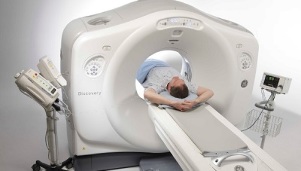
Chest osteochondrosis is rare, but can cause many complications. To make a correct diagnosis, it is important to make a comprehensive diagnosis. Treatment should be timely and comprehensive. Preventive measures will help prevent the development of such a disease.
Thoracic lumbar osteochondrosis is a degenerative disease of cartilaginous structures. Without timely and competent treatment, osteochondrosis can lead to various complications, so it can not be ignored. Preventive measures will help prevent such a pathology.
General features of the disease
Osteochondrosis is a fairly common lesion of the musculoskeletal system, but rarely affects the chest compared to other parts of the spine. This is due to the fact that this part of the spine is the least mobile, so it experiences less stress.
This feature is a danger of the disease - the symptoms are less pronounced, so patients with advanced osteochondrosis see a doctor.
The disease is characterized by the development of degenerative and dystrophic processes. They cause pathological changes that affect bone and cartilage tissue. When left untreated, it changes the structure of pathological ligaments, intervertebral discs, and joints, leading to their destruction.
With the development of osteochondrosis, first the bone structures are affected, then the pathological process spreads to cartilage structures, muscles, connective tissue. At a young age, such pathological changes lead to premature aging of the body.
Classification
The pathology is characterized by gradual progression, so there are four stages (degrees), each of which is characterized by certain clinical manifestations and complications:
- The first stage usually involves rupture of the intervertebral disc, which can cause excessive stress or sudden movement.
- In the second stage, the protrusion of the intervertebral discs is observed. In this case, the disc protrudes into the intervertebral canal - the protrusion is generally not more than half a centimeter. At this stage, the instability of the spine develops.
- The third stage of osteochondrosis is characterized by an increase in the intensity of clinical manifestations and is often accompanied by an intervertebral hernia.
- The fourth stage of the disease is called the most severe and dangerous. Osteophytes appear at this stage. Their proliferation puts pressure on the spinal cord and nerve endings.
Reasons
Osteochondrosis can develop at any age. The risk is not related to gender.
The disease often develops against the background of the following factors:
- age - people over the age of 40 are at risk;
- various pathologies of the spine, including curvature of the spine;
- hereditary tendency;
- trauma resulting in damage to the intervertebral discs;
- chronic stress;
- hypothermia;
- hormonal imbalance, metabolism;
- circulatory disorders in the chest area;
- Features of professional activity that create an increasing load on the chest area.
Symptoms of thoracic osteochondrosis
The disease can have different symptoms and is sometimes atypical. Often the pathology is expressed by the following symptoms:
- Pain. This symptom is the basis. Painful sensations usually occur when the body is in a position for a long time, when physical tension, lifting weights. When the pathology develops, the pain can be observed at rest and intensifies with any movement. It can be dull or painful.
- Crush in the middle of the back. In this situation, it is more difficult for a person to breathe. The pain is felt when you breathe or take a deep breath.
- Parts of the body match.
- There may be colds and gas spills.
- Local temperature decreases in the legs.
- Itching and burning may be felt in the lower extremities.
- If the pathology affects the cardiovascular system and causes its deterioration, it may be accompanied by peeling of the skin, thinning of the nail plates and increased fragility of the nails. With the development of osteochondrosis, the organs of the gastrointestinal tract are disrupted, which can lead to a number of symptoms: nausea, heartburn, abdominal pain, diarrhea, constipation, abdominal pain.

Pain is one of the main symptoms of thoracic osteochondrosis, but it can manifest itself in completely different ways. In some cases, dorsalgia is observed - painful sensations appear at the site of the lesion and last for a long time. In other cases, dorsal pain occurs - the pain manifests itself sharply and sharply, occurs in paroxysms, tightens the muscles and impedes breathing.
The clinical picture of osteochondrosis depends mainly on its stage:
- In the first stage of the disease, intervertebral disc rupture is usually observed. This phenomenon is characterized by severe pain and muscle tension. The discharge of sensations is reminiscent of the effect of an electric current that appears to pass along the spine.
- In the second stage, there may be a bulge in the chest, which is accompanied by pain and can affect the internal organs.
- Pain is more common in the third stage of the pathology. The patient has difficulty breathing, headaches appear. The disease can slightly impair the heart.
- In the fourth stage, intercostal neuralgia may develop due to compression of the nerve roots. In this case, a sharp pain occurs in the chest. At first it affects only one area, but then spreads throughout the chest. This makes it difficult to breathe. The patient is sometimes unable to change the position of the body, the pain intensifies several times during various movements, can be unbearable. Pupils may dilate due to severe pain.
Symptoms of osteochondrosis of the thoracic region usually increase at night, which is due to the fact that the body stays in a horizontal position for a long time. After waking up, the symptoms become less intense or disappear altogether, but sudden movements or low body temperature can increase them.
Atypical manifestations of thoracic osteochondrosis include the following symptoms:
- Painful sensations in the heart. Such a manifestation increases the suspicion of heart attack or angina pectoris. Sometimes this symptom lasts for several weeks.
- Concentration of abdominal pain that causes serious discomfort in the gastrointestinal tract. This symptom increases with physical activity.
- Acute spastic pain in the upper abdomen. This symptom is characteristic of gastritis, pancreatitis, cholecystitis.
- Exacerbation of the disease in women can cause cramping pain in the mammary glands. In this case, there is a suspicion of a malignant neoplasm.
- Disorders of the genitourinary system.
- If the pathological changes are concentrated in the upper part of the chest, the pain may affect the esophagus or esophagus. In this case, patients complain of a foreign body sensation in the throat.
Only a doctor can diagnose. In addition to osteochondrosis of the chest, there are many symptoms that are characteristic of other pathologies. An expert will be able to understand all the nuances of the clinical picture.
Diagnostics
The doctor can already make an initial diagnosis at the stage of the initial examination of the patient. Generally, a neurologist deals with the problem of osteochondrosis. The doctor examines the spine in different body conditions.
They resort to instrumental diagnostics to confirm the diagnosis and determine the features of the pathology. The main work is radiography.

In addition, the following measures can be applied:
- computed tomography;
- magnetic resonance imaging;
- scintigraphy;
- discography;
- electromyography.
They also resort to laboratory diagnostics. May include general and biochemical blood and urine tests. Such studies are conducted in order to determine the differential diagnosis, the characteristics of the pathology, the associated complications.
Diagnosis is necessary not only to confirm the diagnosis, but also to distinguish osteochondrosis from other pathologies. The clinical picture with atypical course is similar to other pathologies that may not be associated with the breast area.
Treatment of thoracic osteochondrosis
The disease requires a comprehensive treatment. It covers not only the use of drugs, but also various physiotherapy methods, physiotherapy exercises, massage.
Bed rest is required during the exacerbation of the disease. Mobility should be limited as much as possible. Often the pain syndrome is so severe that the patient calls an ambulance. In this case, treatment is carried out in a hospital.
Limit movement during treatment. You can walk when you no longer need bed rest, but long walks are forbidden. Walking should be replaced by rest. Also, you should not sit in one position for a long time.
Traction is used in advanced disease. This technique involves stretching the spine. This allows you to increase the distance between the vertebrae, reduce the size of the intervertebral hernia and activate the nourishment of the intervertebral discs.
Drug treatment
Various medications for osteochondrosis of the breast are used to relieve pain, muscle tension and improve blood supply. The following medications may be prescribed for this purpose:
- Drug treatment is generally based on non-steroidal anti-inflammatory drugs that relieve pain and inflammation. Such drugs are prescribed in the form of ointments and gels for external use, tablets and capsules for oral administration, solution for injection. Therapy may involve the simultaneous use of several drugs of the same group. The therapeutic course usually lasts 1-2 weeks.
- Use glucocorticosteroids for severe pain. The drugs are usually used for intramuscular injection or physiotherapy.
- Analgesics are also used for severe pain.
- In case of unbearable pain, they resort to drug blockage. Blockades are carried out strictly in accordance with the indications in a hospital setting.
- Local irritants can help reduce pain. They can be based on natural ingredients - hot pepper extract, bee or snake venom.
- Intramuscular injections of nicotinic acid are prescribed to restore blood circulation in the affected area.
- Muscle relaxants are used to reduce muscle tension.
- After the cessation of the disease, drugs are often prescribed to activate metabolic processes and restore cartilage structure. This effect is provided by chondroprotectors. This medication covers a long therapeutic course lasting several months.
Only a doctor can prescribe the necessary medication for a particular situation. It is necessary to determine the duration and scheme of administration of each drug, taking into account the compatibility of different drugs.
Physiotherapy and massage
Physiotherapy methods with thoracic osteochondrosis allow to get rid of pain and restore mobility. The doctor may prescribe the following treatments:
- electrophoresis or phonophoresis with drugs, including anti-inflammatory and analgesic drugs;
- magnetic therapy;
- darsonvalization;
- paraffin wax applications;
- ozokeritotherapy;
- balneotherapy;
- ultrasound;
- mud treatment;
- UHF therapy.

Massage should be given special attention in thoracic osteochondrosis. The following methods can be involved in the treatment of such pathology:
- Classic.In this case, the massage consists of lightly stroking, kneading, bathing, rubbing. Such treatment should be a course. A course can have 15 sessions, each lasting no more than 20 minutes.
- Stain.The effect can be painful or acupuncture points. The movements are performed by gradually increasing the force by pressing in a circle with the fingertips.
- Canned.The use of cans allows you to create a vacuum that increases blood circulation and lymph drainage. Bucket massage increases muscle tone, eliminates pathological reflexes, accelerates the microcirculation of various fluids in the body.
- Segmental.This massage is performed to improve blood supply to the affected area, stimulate lymphatic drainage and oxygenation of tissues.
Healing gymnastics
Physiotherapy exercises have an excellent effect on thoracic osteochondrosis. It should be done under the supervision of a specialist, but some exercises can be done at home:
- Warm up before therapeutic gymnastics. For this purpose, you can take a shower and warm up a bit. It consists of shaking hands, turning, torso turns.
- Lie on the floor, on your stomach. Place both hands behind your head while spreading your elbows. Slowly lift your shoulders and body. Pull the right elbow first, then the left. Repeat 5 times.
- In the same starting position, put your hands behind your back and lock them. Make a bend in the trunk and lift your arms up without opening them. You should lie down for a few seconds at the extreme point and return to the original position smoothly.
- Get on the floor and put your hands behind your shoulders. Raise your shoulders in turn, moving your head in the same direction.
- Lie on your stomach on a hard surface. Extend your arms forward as you lift your body. Repeat a few times, then perform the same body lifts, but with arms stretching across the body.
- Sit in a chair and put both hands on your belt. Move the shoulder girdle, lift it smoothly and lower it to its original position. You should stop for a few seconds at the extreme point. Repeat 5 times.
- This exercise should be done with a gymnastic stick. You need to sit up while breathing and raise your arms holding a stick. Return to the starting position on exhalation and lean forward.
- Get on the floor and put your hands on your shoulders with a gymnastic stick. Then turn the body left and right. This exercise is contraindicated in scoliosis.
- Sit in the back seat, lean on it and lean back.
All exercises should be done smoothly and slowly. Acute movements are excluded. If a workout is painful, you shouldn't do it and get some rest. If the pain persists, exercise should be stopped and a doctor should be consulted.
Prognosis, complications
The prognosis is favorable for timely detection and competent treatment of thoracic osteochondrosis. If the disease is neglected, life expectancy is reduced by about 7%.
The development of osteochondrosis can lead to the development of other pathologies:
- protrusion of the intervertebral disc as it exits the intervertebral canal;
- intervertebral hernia - in contrast to the protrusion, involves the rupture of the ring fibrosis;
- narrowing of the intervertebral canal, vertebral artery;
- radiculopathy - a complex of symptoms that occur when the roots of the spinal cord are damaged;
- kyphosis - popularly called humerus and refers to the curvature of the spine, the reversal of the bulge (sagittal plane);
- pneumosclerosis;
- zone;
- malignant neoplasms;
- sexual dysfunction.
Prevention
Preventing any disease is easier than stopping and treating pathological changes that already occur.
Adherence to the following preventive measures will help prevent osteochondrosis of the breast:
- Maintain normal body weight.
- Moderate physical activity. You need to exercise regularly or at least exercise daily. It is important to include elements that strengthen the back muscles in the set of exercises.
- Avoid injuries and physical exertion.
- If necessary, maintain and correct the correct posture.
- Avoid emotional stress.
- Proper nutrition.
- Eliminate bad habits.
- Proper organization of the bed. It is important to choose the right mattress, focusing on your individual characteristics.
- Organize your workplace properly. If the work is sedentary, then you should look at a chair with a high back. During this time you need to take breaks and warm up.
- Timely medical examinations.
- Complete and timely treatment of any pathology.
Osteochondrosis of the thoracic spine can lead to various complications that adversely affect quality of life. At the first signs of pathology, it is necessary to consult a doctor who will diagnose and prescribe an authorized treatment. All rules must be strictly followed.























